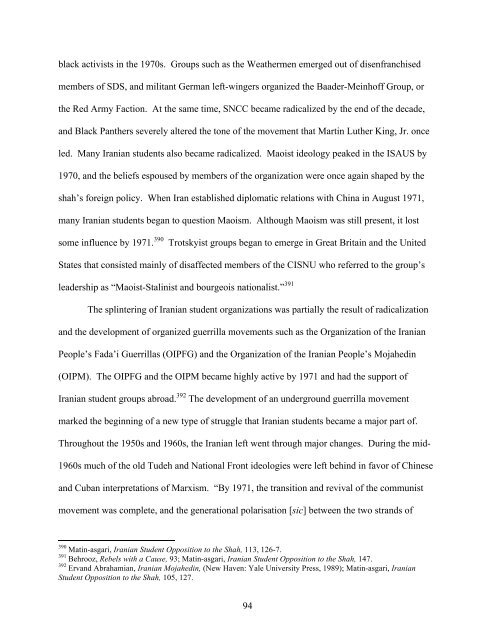AN AUGURY OF REVOLUTION: THE IRANIAN STUDENT ...
AN AUGURY OF REVOLUTION: THE IRANIAN STUDENT ...
AN AUGURY OF REVOLUTION: THE IRANIAN STUDENT ...
You also want an ePaper? Increase the reach of your titles
YUMPU automatically turns print PDFs into web optimized ePapers that Google loves.
lack activists in the 1970s. Groups such as the Weathermen emerged out of disenfranchised<br />
members of SDS, and militant German left-wingers organized the Baader-Meinhoff Group, or<br />
the Red Army Faction. At the same time, SNCC became radicalized by the end of the decade,<br />
and Black Panthers severely altered the tone of the movement that Martin Luther King, Jr. once<br />
led. Many Iranian students also became radicalized. Maoist ideology peaked in the ISAUS by<br />
1970, and the beliefs espoused by members of the organization were once again shaped by the<br />
shah’s foreign policy. When Iran established diplomatic relations with China in August 1971,<br />
many Iranian students began to question Maoism. Although Maoism was still present, it lost<br />
some influence by 1971. 390 Trotskyist groups began to emerge in Great Britain and the United<br />
States that consisted mainly of disaffected members of the CISNU who referred to the group’s<br />
leadership as “Maoist-Stalinist and bourgeois nationalist.” 391<br />
The splintering of Iranian student organizations was partially the result of radicalization<br />
and the development of organized guerrilla movements such as the Organization of the Iranian<br />
People’s Fada’i Guerrillas (OIPFG) and the Organization of the Iranian People’s Mojahedin<br />
(OIPM). The OIPFG and the OIPM became highly active by 1971 and had the support of<br />
Iranian student groups abroad. 392 The development of an underground guerrilla movement<br />
marked the beginning of a new type of struggle that Iranian students became a major part of.<br />
Throughout the 1950s and 1960s, the Iranian left went through major changes. During the mid-<br />
1960s much of the old Tudeh and National Front ideologies were left behind in favor of Chinese<br />
and Cuban interpretations of Marxism. “By 1971, the transition and revival of the communist<br />
movement was complete, and the generational polarisation [sic] between the two strands of<br />
390 Matin-asgari, Iranian Student Opposition to the Shah, 113, 126-7.<br />
391 Behrooz, Rebels with a Cause, 93; Matin-asgari, Iranian Student Opposition to the Shah, 147.<br />
392 Ervand Abrahamian, Iranian Mojahedin, (New Haven: Yale University Press, 1989); Matin-asgari, Iranian<br />
Student Opposition to the Shah, 105, 127.<br />
94















